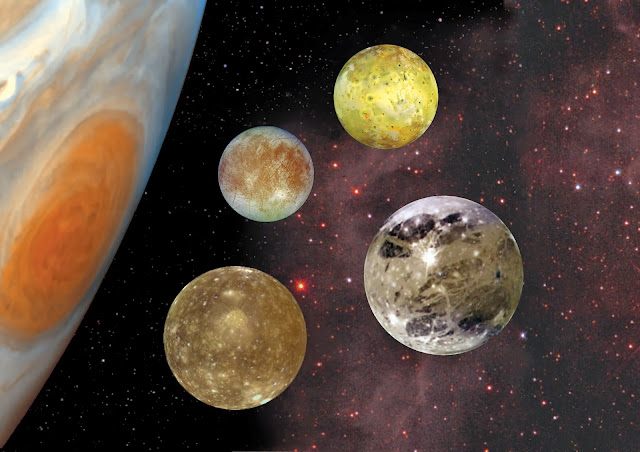A Planetary Ring and 64 Moons Around Planet Jupiter:
Biggest Planet and Biggest Moon in the Solar System
 |
| PHOTO : A Planetary Ring and 64 Moons Around Planet Jupiter |
Jupiter is the fifth planet from the Sun and the biggest planet of the Solar System, its mass being more than twice as big as all the other planets combined. Along with Saturn, Uranus and Neptune, the four giant planets are known as the Jovial.Planet Jupiter has mostly in its component hydrogen and helium, but it might also have a rocky core of heavy elements. Due to the high speed of its rotation, Jupiter has the shape of an oblate spheroid, having both poles closer to the core than the equator. The outer atmosphere of Jupiter is divided into separated latitude layers, which cause turbulence and storms when they interact. The most significant result of the layers interaction is a giant storm still in process, discovered in the 17th century . This storm is known by the name of the Great Red Spot.Jupiter is surrounded by a slightly detectable planetary ring and a strong magnetosphere. What makes this planet interesting is not only its size, but also the fact that Jupiter has 64 moons. Four of the moons are very famous: Io, Europa, Ganymede and Callisto, also called the Galilean moons, after their discoverer Galileo Galilei. Ganymede is the biggest natural satellite in the Solar System, being bigger than the planet Mercury.Along with the Sun, the Moon and planet Venus, Jupiter is the fourth largest object seen by the naked eye. The gravitational influence of planet Jupiter played a very important role in the shaping process of the solar System. Thereby, the majority of the planets orbit closer to Jupiter’s orbital plane than to the Sun’s equatorial plane. Mercury is the only planet that makes an exception, being closer to the Sun. Also, it’s high gravitational level might have caused the Kirkwood gaps in the asteroid belt and the Late Heavy Bombardment of the inner Solar System’s history.Distance from Earth: 0.0000621 light years, about 32 light minutes
- FASHION WEEK - USA Fashion and Music News
- PALCO MP3 - Download Music Legally Direct From Artist
- LAST FM - Download Music Legally Direct From Artist
- PICASA WEB - USA Fashion Music News Photo Gallery
- DISNEY CHANNEL - Music News
- BABY JUSTIN BIEBER - Google Images Google News
- LADY GAGA - Google Images Google News
- UNIVERSE PICTURES - Google Images Nature Picrtures
- FLICKR PHOTOS - Fashion Magazines
No comments:
Post a Comment